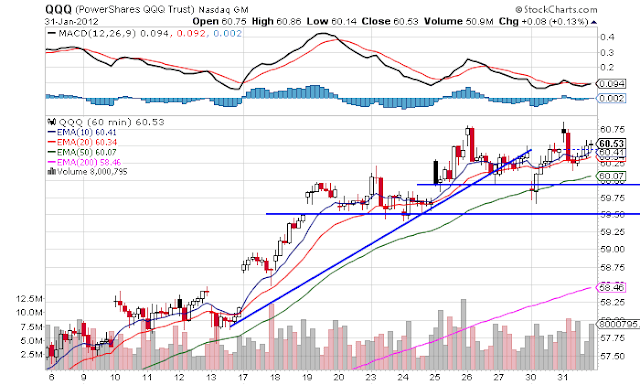- by New Deal democratFirst, as to the monthly reports, home sales continued poor, but consumer confidence jumped back further, completely regaining its pre-debt debacle levels. In the rear view mirror department, 4Q 2011 GDP was +2.8% although some internal components were weaker. Those few sources who thought a new recession might begin by the end of 2011 were almost certainly wrong.
Turning now to the
high frequency weekly indicators:
Weekly
employment-related data was mixed.
The
BLS reported that Initial jobless claims rose by 25,000 to 377,000, which is still an excellent in comparison with almost any report in the last 4 years except for the week preceding. This is the last report affected significantly by seasonality. The four week average declined by 1500 to 377,500. This is close to the lowest level since mid-2008.
The
American Staffing Association Index rose by 3 to 87 last week, the best January reading since 2008, and significantly ahead of last year.
The
Daily Treasury Statement showed that withholding for the first 17 days of January 2012 was $138.6 B vs. $132.7 B a year ago. Adjusting +0.27% due to the 2011 tax compromise, for the last 20 reporting days, $162.0 B was collected vs. $156.9 B a year ago, a gain of +3.3%.
Housing data was mixed:
The
Mortgage Bankers' Association reported that seasonally adjusted purchase mortgage applications decreased 6.5% YoY and was also down -9.7% from one week ago. The overall trend remains flat since June 2010. Refinancing fell -5.2% in the last week.
For the seventh week in a row, YoY weekly median asking house prices from 54 metropolitan areas at
Housing Tracker were positive, up +3.7% YoY. This is the best reading in close to 5 years. The number of metropolitan areas with YoY positive sking prices increased to 31. The number with YoY declines of greater than 5% decreased to 7.
Sales and transportation continued positive:
Retail same store sales were relaitvely weak. The
ICSC reported that same store sales for the week ending January 21 increased 2.8% YoY, but were down -1.4% week over week.
Shoppertrak, did not report, however,
Johnson Redbook reported a weak 2.5% YoY gain, the weakest in 6 months.
The
American Association of Railroads reported an increase in weekly rail traffic for the week ending January 21, 2012, with U.S. railroads originating 287,734 carloads, up 1.6 percent compared with the same week last year. Intermodal volume for the week totaled 219,706 trailers and containers, up 3 percent compared with the same week last year.
Money supply and
Credit spreads were also positive:
M1 increased +0.4% last week, and +2.3% month over month. It is also up 18.9% YoY, so
Real M1 is up 15.9%. This is about 5% off peak YoY gain at the end of last summer. M2 was up +0.2% week over week, and up +1.4% month over month, and up 10.1% YoY, so
Real M2 was up 7.1%. This is about 3% less than its YoY reading at the crest of the tsunami.
Weekly
BAA commercial bond rates declined .01% to 5.20%. Yields on 10 year treasury bonds rose .01% 1.96%. Falling spreads on lower rates is the best signal of improvement, although it is only for two weeks. This spread had a 52 week maximum difference in October and has been tightening slightly in the last few weeks.
Gasoline usage in particular continues to be much lower YoY:
Oil rose slightly to close at $99.56 a barrel on Thursday. This is about at the recession-trigger level calculated by analyst Steve Kopits (adjusted for general inflation). Gas at the pump was flat at $3.39. Measured this way, we are just at or slightly above the 2008 recession trigger level. Gasoline usage, at 8098 M gallons vs. 8632 M a year ago, was off -6.2%. The 4 week moving average is off -6.4%. Since last March the YoY comparisons have been almost uniformly negative, and substantially so since July. It's at least possible some of this reflects the unusually warm winter most of the country has been experiencing.
Now let's turn to new high frequency indicators designed to
track the global slowdown/recession:
The
TED spread is at 0.500 down from 0.520 week over week. This index is slightly above its 2010 peak, but has declined from its 3 year peak of 4 weeks ago. The one month
LIBOR is at 0.270, down .007 from one week ago, below its 12 month peak of three weeks ago, and also remains below its 2010 peak.
The
Baltic Dry Index at 726 continued to plummet -136 as it has for the last 4 weeks and further continues to decline from its October 52 week high of 2173. The
Harpex Shipping Index was declining for a full year, but at 394 is above its 52 week low of 389 three weeks ago. It declined -2 last week. Please note that these two indexes are influenced by supply as well as demand, and have generally been in a secular decline due to oversupply of ships for over half a decade. The Harpex index concentrates on container ships, and has been leading at recent tops and lagging at troughs. The BDI concentrates on bulk shipments such as coal and grain, and has been more lagging at the top but has turned up first at the 2009 trough.
Finally, the unweighted Shadow Weekly Leading Index was slightly negative this week. Next day, so was the ECRI WLI. Once again I not surprised.
Global worries have continued to abate. In the US virtually all the news is positive, but some weakly so, and mortgage applications contnue to bounce up and down along their two year bottom. There remains no sign of any present or imminent downturn in the economy right now.
Have a good weekend.
































